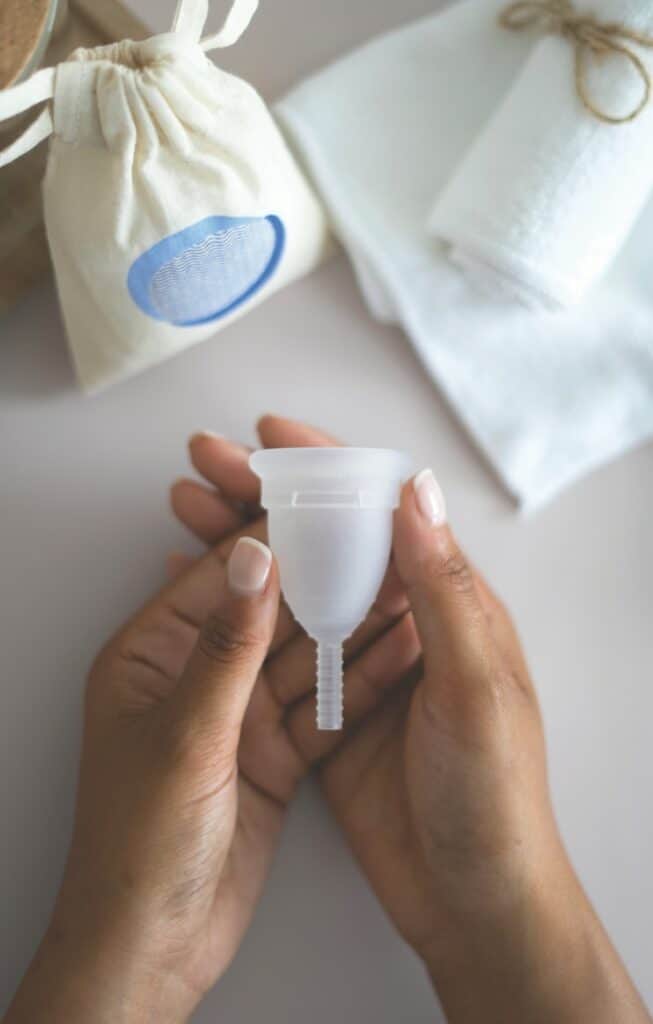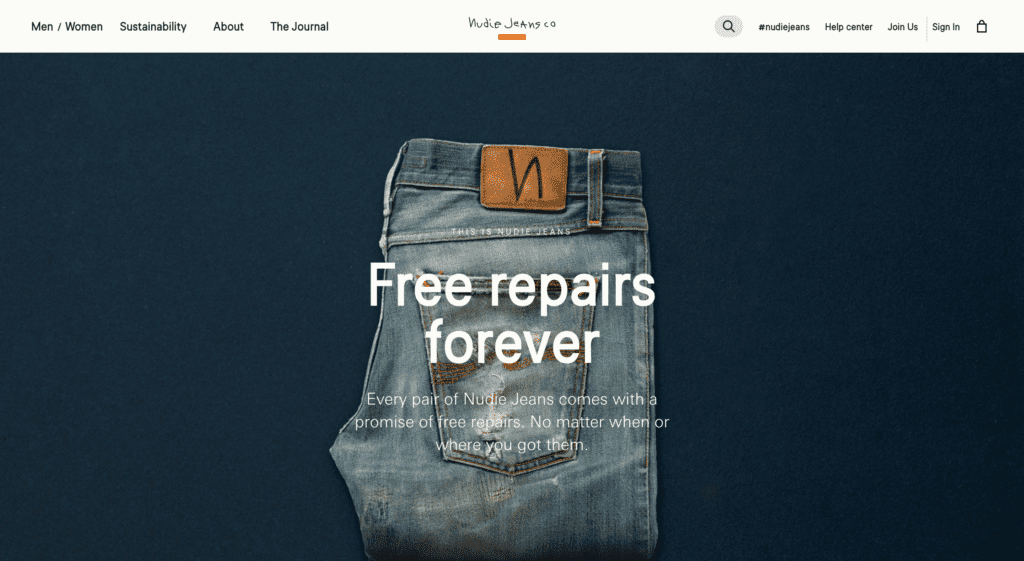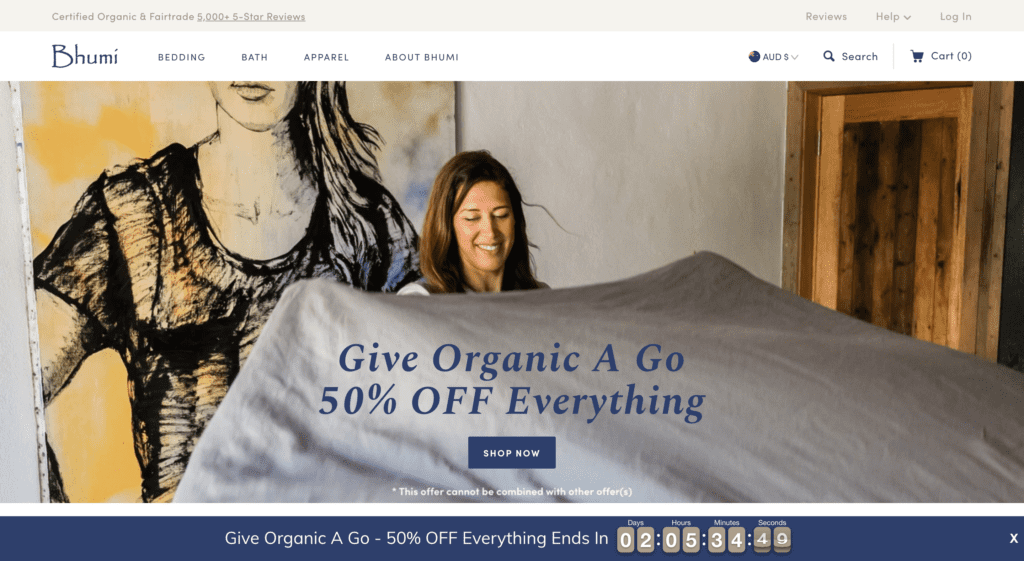[ad_1]
It’s no secret why sustainable products are more expensive than conventional ones. But why the price difference? And more importantly, is it worth paying extra for sustainability?
In this blog post, I’ll answer these questions and give you some tips on saving money when shopping for eco-friendly alternatives.
How much more expensive are sustainable products?
You’ve probably walked into your local organic grocery store, looked at the prices and walked back out. I’ve been there!
Or perhaps you’re ready to move on from $2 Kmart T-shirts only to realise that the actual cost of a sustainably sourced Tee is over $40.
Mindful consumers have all had these experiences. But is the discrepancy in price between eco-friendly and conventional really that significant?
According to a study by Netherlands consulting firm Kearny, green products are 75-85 per cent more expensive than conventional products.
Yikes!
I’m sure this research checks out, but I’m hopeful it’s not that bad. So let’s do a quick exercise. Below I’ve listed some sustainably made products I routinely buy and compared them against the conventional alternatives I used to support back in the day.
Note that the figures are in AUD, but the margins should translate to most currencies.
| Food | Conventional | Organic | Difference |
| Rice | $1.40 | $4.00 | 185.71% |
| Pasta | $1.00 | $1.65 | 65.00% |
| Canned tomatoes | $0.80 | $1.20 | 50.00% |
| Ice cream (dairy-free) | $6.60 | $22.00 | 233.33% |
| Tofu | $3.65 | $4.80 | 31.51% |
| Celery | $3.90 | $7.00 | 79.49% |
The average percentage difference between conventional food and organic food was 107.51%.
| Personal care | Conventional | Natural | Difference |
| Deodorant | $3.90 | $7.00 | 79.49% |
| Toothpaste | $5.50 | $9.95 | 80.91% |
| Hand wash | $2.79 | $8.00 | 186.74% |
| Body lotion | $8.00 | $19.95 | 149.38% |
| Toilet paper | $12.00 | $34.00 | 183.33% |
The average percentage difference between conventional personal care and natural personal care was 135.97%.
| Fashion | Conventional | Eco | Difference |
| Sneakers | $120.00 | $120.00 | 0.00% |
| T-shirt | $2.00 | $31.90 | 1495.00% |
| Hoodie | $16.00 | $90.00 | 462.50% |
| Socks | $1.00 | $9.95 | 895.00% |
The average percentage difference between conventional fashion and eco-friendly fashion was 713.13%.
This was an eye-opening exercise, yes, to see the difference in prices, but to also understand just how cheap some of the conventional products are, especially in fashion.
So why such a price difference? Let’s take a look.
6 Reasons sustainable products come with a premium price tag
Sustainable products are more expensive for several reasons. Below are 6 of the most important ones.
1. Demand
When you’re in the bubble of sustainable living, it seems like everyone is trying to make more eco-conscious decisions — and to an extent, there’s some truth to that.
In 2021, a survey of over 10,000 people from 17 nations found that sustainability is becoming increasingly important to customers’ purchasing choices.
24 per cent of Baby Boomers and Generation X would choose an eco-friendly alternative when available, which jumps to 32 per cent for millennials.
These are encouraging statistics. However, when you look at product availability, only a fraction of our shelves represent sustainable options — showing that demand for these goods still has a long way to go.
What does demand have to do with exorbitant prices?
When there’s little to no demand for an item, companies have nothing to gain from reducing their price as this will not increase sales. In fact, it may even lose them money!
Then there are economies of scale — the more you produce, the less it costs. The production system from machinery, human resources, factories, etc., is set up to create mass-manufactured items.
Therefore, when it comes to sustainable products that are not yet in high demand, companies cannot rely on economies of scale and must charge more for the product.
But, as mentioned earlier, increased awareness and demand from customers is slowly starting to change – which is encouraging.
2. Raw materials
The cost of sustainable products is often higher than conventional products due to expensive raw materials.
These premium raw materials are necessary to produce a product that has a lower environmental impact.
For example, using recycled paper instead of virgin paper saves trees, but recycling the paper costs more than cutting down new trees and using them for pulp.
The same is valid for harvesting organic cotton and using organic dyes instead of conventional cotton and synthetic dyes.
These raw materials cost more because they are produced in smaller quantities, but that higher price tag is the cost we must pay to help reduce our environmental impact on this planet.
Another example is sustainable construction materials. Sustainable buildings cost more to construct than conventional buildings, but the long-term savings offset this increased energy and maintenance costs.


Additionally, sustainable buildings are healthier and more comfortable places to live or work in, contributing to their value.
3. Toxins
The use of chemicals like preservatives and pesticides is a way to keep the price of products down. By using these chemicals, companies can avoid using more natural/expensive preservation or pest control methods.
While there are health and environmental risks associated with their use, the commercial benefits often outweigh the risks in the eyes of these companies.
The omission of toxins in eco-friendly products increases those products’ costs compared to conventional alternatives. This is because those items must meet a higher standard to ensure that they are safe for human use and do not contain harmful chemicals.
For example, a conventional cleaning product can contain harmful chemicals such as:
- Chloroform is an anaesthetic that can cause liver failure and has been linked to cancer.
- Diethylene glycol monomethyl ether (DEGME) is used in brake fluid. It causes eye irritation and corrosion of the skin.
- Dimethyl glycol (DEG) is used in paint and nail polish remover. It can cause eye irritation and damage to the central nervous system if inhaled or absorbed through the skin over a long period.
Conversely, a natural cleaning product cannot contain any of the above chemicals and must be made from non-toxic materials. This means that it will cost more to produce than its conventional counterpart, which explains why eco-friendly products are generally more expensive than their counterparts.


4. Wages
One of the largest expenses for businesses is wages. The cost of labour can make or break a company.
It’s no secret that many businesses are underpaying their employees and contractors. This is because they feel like they can get away with it. But the consequences of this practice are far-reaching.
One reason for this is competition; other companies may pay more than you and steal your talent if you don’t keep up.
Another reason is greed; your company might think it can profit by not giving its workers what they deserve.
How poorly are workers paid? Offshore contractors for large companies can be paid as little as $0.15 per hour, while workers in the United States make an average of $29.81 per hour. This is a huge discrepancy, and it will only worsen if we don’t take action.
On the other hand, sustainable businesses understand that paying employees fairly is not only the right thing to do, but it’s also good for business.
When workers are paid a livable wage, they can afford basic needs like food and shelter. This means they can spend money in their local community, which helps businesses grow. In addition, when workers feel appreciated and valued, they are more likely to stay with the company long-term.
However, sustainable businesses have higher labour costs than their competitors. This means they need to find other ways to make money by charging more per product or service.
In addition, these companies may be unable to compete on price with non-sustainable businesses that are willing to pay workers less than minimum wage and don’t provide benefits like healthcare.
5. Certifications
Certifications can often drive the price of a product up, as they require more rigorous testing and inspection. Organic, fairtrade, b-corp, and leap bunny certifications are all designed to ensure that the product is sustainable and ethical.
This increases the cost of production, as these certifications require extra time, money, and resources. For instance, organic certification fees can be thousands of dollars depending on the volume and variety of products, and the audit process can take months.
Leap Bunny Certification is the most rigorous and expensive of all the certifications. It requires companies to go through a detailed application process that covers animal testing, ingredient disclosure, marketing claims, and manufacturing processes. Certification also requires annual audits to ensure that companies comply with the certification policy.
Although these certifications can be expensive and time-consuming, they provide consumers with peace of mind knowing that their purchases are ethical and sustainable.
Unavoidably, some of these costs are passed on to the customer, driving up prices.
6. Business practices
Companies that produce sustainable products tend to adopt eco-friendly business practices themselves like:
- Installing solar panels
- Using energy-efficient appliances,
- Allocated staff time to contribute to environmental causes
It’s almost a requirement for these businesses to adopt these practices. Otherwise, they’ll be seen as hypocritical to the public eye. There’s pressure to “walk your talk”.
But these practices can add up and increase expenses across the company. So how do these businesses stay afloat and continue to make a difference? You guessed it. Pass on some of those running costs to the end consumer.


Why you should still consider supporting sustainable brands
It all starts with demand. With more demand, eco companies will increase their sales and profits, thus enabling them to have more buying power with suppliers and reach economies of scale to reduce overheads.
Perhaps more importantly, demand will attract more players into the market, which will increase competition. And with competition comes the pressure to decrease prices to attract and retain customers.
As a result, demand for sustainable products and services will increase in tandem with the reduction of prices.
Also, more people will be able to afford these eco-friendly alternatives, which heightens awareness and education on the importance of sustainability – an effect that contributes to positive change.
How to approach shopping for sustainable products when it’s outside of your budget
It can be overwhelming to not only find sustainable products that meet your needs but then to fork out the money to shop in line with your values.
As someone who’s struggled to justify the cost at times, I’ve found relative peace with the “trade-off”.
And to put it into perspective, as a scrappy digital creator, my income is far from what many would consider a good living — and yet, I rarely compromise when given the option to support eco over conventional.
So here are some tips to consider when trying to navigate the prices of eco-friendly products.
Reset your expectations
Perspective is vital when voting with your hard-earned cash. We’ve been conditioned to acquire items as cheaply as possible — to the point where $1 for a garment is normal.
The same cognitive dissonance that plagues animal cruelty also applies to eco-friendly choices.
So the first step in finding better prices for sustainable goods is ironically to reverse a lifetime of conditioning for seeking the lowest possible prices all the time.
It’s when you’re open will you start to see the savings. Until you reach that point, you’ll be conflicted because you’ll be comparing the price of sustainable items against conventional items instead of sustainable items against other sustainable items.
So are you prepared to pay more for a sustainable future? If yes, then you’re ready to cut costs.
Reduce repeat purchases of personal care products
In perpetuity, we repeatedly purchase personal care items like deodorant, body lotion, shampoos, toothpaste, etc.
I made an early mistake when switching to eco-friendly products by comparing the price on product shelves while not considering the repeat purchase costs.
This is critical for your budget as, generally speaking, sustainable alternatives are quite potent, and often you don’t need to apply as much to reach a level of effectiveness.
For example, suppose you’re draining yourself in Lynx deodorant daily versus using a small finger-full of deodorant paste on each armpit. In that case, you’ll need a higher volume of Lynx deodorant over the course of a year.
This is not to say that less volume works out to be cheaper, but its cost is more favourable than perhaps you initially thought.
Another example is menstrual pads, which need to be disposed of and repeatedly purchased. Swapping disposable pads for reusable pads or menstrual cups will not only save you money but will have a significantly reduced ecological footprint.


If you’re struggling with this, the data doesn’t lie. Track how often you repurchase your personal care products, then switch over to a premium sustainable alternative and see how they compare over 6 months to a year.
Be prepared to work harder for groceries
There are savings to be made when buying organic foods if you’re willing to put in the effort.
The first mistake we make is relying solely on the supermarket or health food stores for organic food. It’s in these places that prices are exorbitantly high. Not for everything, but for some items. And therein lies the issue.
To save money on food, at least in my experience, you need to be okay with sourcing specific ingredients from different suppliers.
Here’s what our weekly food shopping looks like:
- Supermarket – canned legumes, oils, tofu, tempeh, mushrooms, plant-milk
- Farmer’s market – general fruits and vegetables
- Bulk food stores – general fruits and vegetables (not available at the farmers market), spices, nuts, seeds, grains, dried legumes, salt
- Organic grocer – gluten-free bread
As you can see, we’re getting food from various locations depending on the cost of certain foods. It’s a bit of a pain to do the rounds, but we make significant savings by understanding the going rates at each supplier.


On top of this, we’re regularly on Facebook marketplaces to buy produce from locals in our area. For instance, a lady down the road sells her backyard lemons at $0.50 per lemon compared to $1.40 in the supermarket. Not only do we make savings, but her lemons are superior to anything we can get in the shops.
Lastly, you’ve heard it before, but it’s worth repeating. Buy produce in season. It’s not only better for the environment, as the food travels less to get to the shelves, but it also tends to be cheaper (and tastier!).
Pay for post-purchase services to extend the lifespan of your things
Forward-thinking brands offer services to repair your products. The most common example is Apple, with its Genius Bar support — where you can get your battery or screen replaced to breathe new life into your technology, for a fraction of what you’d pay for a new device.
But smaller sustainable companies like Nudie Jeans offer a post-purchase service to recycle or repair your current jeans.


By allocating some of your budget to these services, you achieve 3 things:
- Extend the lifespan of your item, which reduces waste
- Pay a service fee that costs less than replacing the product – saving you money
- You still support the business by paying for their services
Unfortunately, this is still a rare service as businesses need to have enough interest to justify training or hiring employees with the skills to deliver the service. It comes back to the demand issue.
But, even if a sustainable company doesn’t offer post-purchase services, it’s worth asking them to consider it as they might want to do a trial to see if it works.
Buy things on sale…duh!
The most apparent money-saving strategy — shopping conventionally or sustainably, is to wait for sales. I find this particularly easy for buying fashion, homewares and beauty products online.
Retail, especially online retail, works in cycles.
- You’ll typically get a coupon code for signing up for a newsletter
- In fashion, sales come at the end of each season (typically)
- 99% of brands offer discounts on Black Friday and Boxing Day
Wait for these opportunities to buy in bulk and make savings.


Interestingly enough, the small group of brands who don’t participate in sales are more often than not sustainable. This makes sense as they paradoxically have anti-consumerist ideals — which I respect.
So yes, sustainable products are often more expensive than conventional ones, but there are ways to save money when shopping for them.
By sourcing specific foods from different suppliers, buying produce in season, and paying for post-purchase services, you can reduce the cost of going green. Additionally, wait for sales to buy sustainable products in bulk and save money.
Finding balance in trying to live sustainably
In the end, making sustainable products more affordable is a challenge that most companies are struggling with. But there are still ways to save money when shopping for eco-friendly alternatives.
I hope that the next time you’re looking for an eco-friendly product, some of these suggestions will come in handy. Which tip did you find most helpful? How have you found ways to afford to buy eco-friendly products? Share your experiences in the comments.
[ad_2]
Source link
